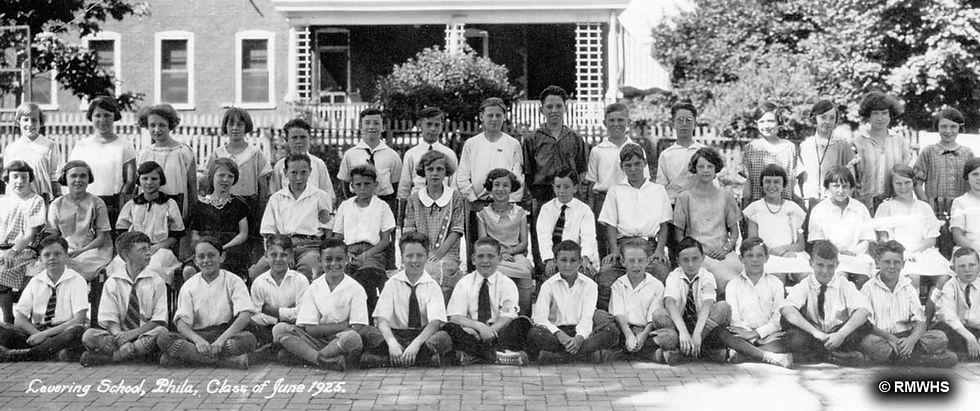Preserving & Promoting
Local History, Art, & Culture




RMWHS Website Images
The changing images in the RMWHS website have generated questions -- Who is in that photo? What building is that? When was the photo taken and where? And the most common question: How can I stop the images from changing so I can study them better?
To address the questions, the individual images have been provided below with some details and a few links to help you discover more about the Roxborough Manayunk Wissahickon area. If you have more questions about the images, contact us. Likewise, if you can identify any of the faces in the group shots, please contact us.

Shawmont Station is the oldest surviving passenger train station in America.
Built in the 1820s, the building became a train station a decade later and was in use until 1991 and was whistle stop until 1995. In 2008, Shawmont was placed on Philadelphia's Register of Historic Places, as the oldest passenger railroad station in America. Owned by SEPTA, the unused building fell further into disrepair until January 2023 when $1.2M of structural renovations began.
For more see the Shawmont Station historic profile in our Local Landmarks section.

Valley Green Inn, built in 1850, is one of the most recognizable buildings in the area as photos of it grace many local interest and travel sites.
Originally it was named Edward Rinker's Temperance Tavern after the man who built it in 1850.
Today, Valley Green is one of the last remaining roadhouses and taverns that had once dotted the banks of the Wissahickon in the 19th Century.

Pencoyd Iron Works 1884 - This photo was donated by the family of George Maurice Miller (Miller is standing on far left in a short hat with beard and mustache).
Born in 1864, Miller graduated from Lehigh University at the age of 16 in 1880. He was approximately 20 years old in this photograph. Miller was said to have been a very hard worker.
On November 14, 1900, he purchased the building near the intersection of Ridge, Righter & Hermit from the Adams family to live in. The house had formerly served as a City Poor House.

This image of the Schuylkill Bridge was taken during construction in May 1925. It is one image in a series currently on display in the RMWHS Archive.
Other photos in the series include the stripping beam forms, removing the centers, the underside of the bridge, and a group shot of the construction crew and other team members.
The crew shot is a particular favorite of visitors to the Archive for the clarity of the image, range of expressions, and the playfulness of one prankster in the group.

The Rag Girls at Hamilton Paper Mill were responsible for sorting old clothing, sailcloth, ropes and other bits of discarded fibrous materials that were used in the production of paper.
The sorting of these "rags" directly determined the type and quality of paper that was made in any given batch. It was a dirty and sometimes dangerous job as the materials sorted could carry germs, disease, and pests.
Can you identify
anyone in this photo?
If so, please let us know.

This Restaurant was located at 4147-49 Main Street Manayunk which became the New Umbria Baptist Church following the church's move from Umbria to Main Street several decades ago.
While the brick front was refaced with white stucco long ago, the distinct arched window and door openings remain to this day as does the keystone accent featured at the top of each rounded arch.

The Roxborough Reservoir Preserve (formerly Upper Roxborough Water Reservoir) on Port Royal and Lare provided this most tranquil view in March 2020. The 35-acre water basin was created in the 1880s to supply water to the growing Roxborough population but today is a nature preserve and part of our city's park system. A trail circles the preserve and is enjoyed regularly by walkers, bikers, birdwatchers, and photographers alike.
To learn more about the history and the transformation, see the RDC's 2019 news story: Roxborough Reservoir Preserve is One of Philadelphia’s Hidden Gems.

This image of the Main Street Market in Manayunk is dated to the 1920s as was determined by the bags of salt located behind the clerk. This particular brand only used that label in the early 1920s. Little else is known about this market, the clerk, or the reason he posed for the photo.
Like the image below, the section shown here accounts for less than 1/4 of the original photograph. It was cropped tightly on the clerk and counter to allow us to show the detail of the scan. The full-size scan allowed archivists to study the products on the shelves and estimate the date the image was taken.

Chas. E. Lentz Garage was located at 6655 Ridge Avenue. This image is only a small part of the original photo and accounts for about 1/4th of the overall image.
The full photo shows cars parked along Ridge Ave on the left. And to the right, much of the house is visible. However, like the photo above, the the drastic cropping of the original image was necessary to highlight the details. In fact, the scan of this image is such a high quality, the bolts on the wheels are visible when it is viewed at full size.

The William Levering School was built as a one room school house in 1748 and named for the man who donated the land.
The first school was built of logs and was used not only for a school, but also for a church and political meetings. The school expanded and was rebuilt a number of times, but William Levering School was finally closed in 2013, after 265 years of educating the children of our community.
Can you identify
anyone in this photo?
If so, please let us know.